Chasen and Tea
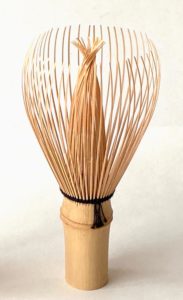
In Chanoyu, ma-tcha, 抹茶, powder-tea, is mixed with yu, 湯, hot water, in a cha-wan, 茶碗, tea-bowl, using a bamboo cha-sen, 茶筅, tea-whisk. What is the reason for the specific structure of the chasen? It is a whisk, and therefore it has many tines for that purpose of blending the tea and hot water. Usucha made in the tradition of Urasenke, creates froth on the surface of the tea, while other Tea family traditions do not create foam.
The number of tines on the whisk varies according to the purpose of its use, and personal choice, but there is a kind of standard between 80 and 100. The length of a standard chasen is 3 sun kujira-jaku or 3.75 sun kane-jaku (4 ½ inches).
The bamboo retains its natural fushi, 節, node, which shows the direction of the growth of the bamboo – the tines are at the root end of the bamboo. When whisking tea, it is as though the bamboo is growing out of the tea. When whisking tea, it is as though the bamboo is growing out of the tea.
Bamboo is a hollow cylinder with multiple septums, fushi, that create chambers that can contain water. This structure has made bamboo useful for a multitude of containers. The septums are removed to create greater capacity, or to act as a gutter for the flow of water. The fushi of the chasen is retained, rather than being removed to create a cylinder. This fushi structure makes the handle end of the chasen, that is a kind of cup. Granted the handle ‘cup’ is quite small.
The length of the standard chasen is 3 sun kujira-jaku. The thread wound three times around the bamboo whisk is located 1.2 sun kujira from the handle end, and 1.8 sun kujira from the tine end. The ratio between 1.2 and 1.8 is 0.666 to infinity. The number 6 is symbolic of Infinity in Time, and water. The number 18 is symbolic of life manifest in the Kanji moku, 木, wood, that is written with jū, 十, ten, and hachi, 八, eight. This is the equivalent of ya-ta, 八咫, eight-span, as manifest in the sacred Shintō Ya-ta-kagami, 八咫鏡, Eight-span-mirror.
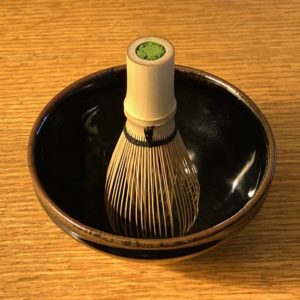
Cha-sen, 茶筅, tea-whisk, with the handle end of the bamboo filled with one teaspoon of ma-tcha, 抹茶, powder-tea. This is equal to the standard amount of tea to make an individual bowl of usu-cha, 薄茶, thin-tea.
The chasen is depicted standing ‘upside down’ in a cha-wan, 茶碗, tea-bowl. The bowl is in the form of a conical Ten-moku, 天目, Heaven-eye.
Chasen made in Japan for Chanoyu are generally the same circumference, and narrower than the whisks made in China. It may be that the Japanese chasen has a specific circumference so that the ‘cup’ is a kind of measure. In a recent test, it was discovered that the capacity of the chasen handle ‘cup’ holds the equivalent of one standard measuring teaspoon. This is the amount of matcha used to make a single bowl, i-ppuku, 一服, one-dose, of usu-cha, 薄茶, thin-tea. The word ‘puku’ is modified ‘fuku’, and refers to an amount such as a dose of medicine, a puff of tobacco, etc. Three chasen ‘cups’ of matcha is the amount of tea used to make an individual’s bowl of koi-cha, 濃茶, thick-tea.
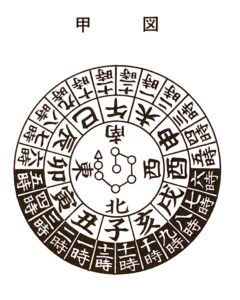
When using a fukusa, 帛紗, cloth-gauze, to purify a Wa-mono cha-ire, 和物茶入, Harmony (Japanese)-thing tea-receptacle, the jar is turned counter-clockwise, like the rotation of the earth. When purifying a Kara-mono cha-ire, 唐物茶入, Tang-thing tea-receptacle, the jar is turned clockwise, like the way the sky appears to turn clockwise. These perceptions are limited to the Earth’s northern hemisphere.
Historically, China regarded itself as the center of the world, which is manifest is its name, Chū-goku, 中国, Middle-country. All of its surrounding territory was regarded as subsidiary. Japan to the east was where the sun came up, Ni-ppon, 日本, Sun-rise. In early history, the Chinese called Japan Wa, 倭, meaning ‘dwarf’, which offended the to-be Japanese people, who attached the Kanji for wa, 和, meaning ‘harmony’.
According to Asian geomancy, the earth is identified as In, 陰, negative, receptive; it is a thing. Any thing is In, just as the word thing included the word ‘in’. The sky is Yō, 陽, positive, penetrative; it is nothing, relative to the substantial physicality of the Earth. The Earth and the sky ‘move’ in different directions. The sun rises, or the Earth turns toward the sun. This is earthly perception. Eventually, it was understood that the Earth was turning, and the surface moved east, which is, in modern parlance, counter clockwise. The sun ‘moved’ to the west, clockwise.
The cha-ire, 茶入, tea-receptacle, is symbolically identified with the sun, Tai–Yō, 太陽, Great-Yang. The cha-wan, 茶碗, tea-bowl, is symbolically identified with the moon, Tai-In, 太陰, Great-Yin. The mizu-sashi, 水指, water-indicate, is identified with the stars, hoshi, 星, star.
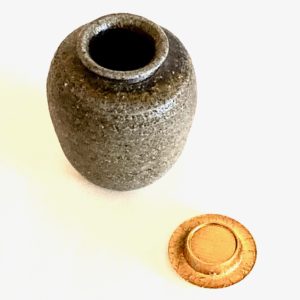
Cha-ire,茶入, tea-receptacle, ceramic jar with kata-tsuki, 肩衝, shoulder-thrust, with ash-glaze, Chō-setsu-gama, 聴雪窯, Listen-snow-kiln, by Tsuchi-da Takeshi, 土田健, Earth-field Strength, Yama-gata, 山形, Mountain-form. With zō-ge buta, 象牙蓋, elephant-tusk lid, interior lined in kin-paku, 金箔, gold-foil.
The chaire is symbolically identified with the sun, and the gold leafed lid evokes the radiance of the sun.
When the chaire is purified with the fukusa, the jar is turned around three times. If the chaire and lid represent the sun, its rotation may be symbolic of time, perhaps three days.
Chasen tines are Yō, because the tines penetrate and move the tea. The handle end of the chasen is In because it can contain and is a solid cylinder with septum. The growth pattern has the tines at the root end. When the chasen is stood upright with the tines pointing up, the bamboo growth is upside down. When the chasen is whisking tea, or being rinsed in the chawan, the bamboo growth is upright.
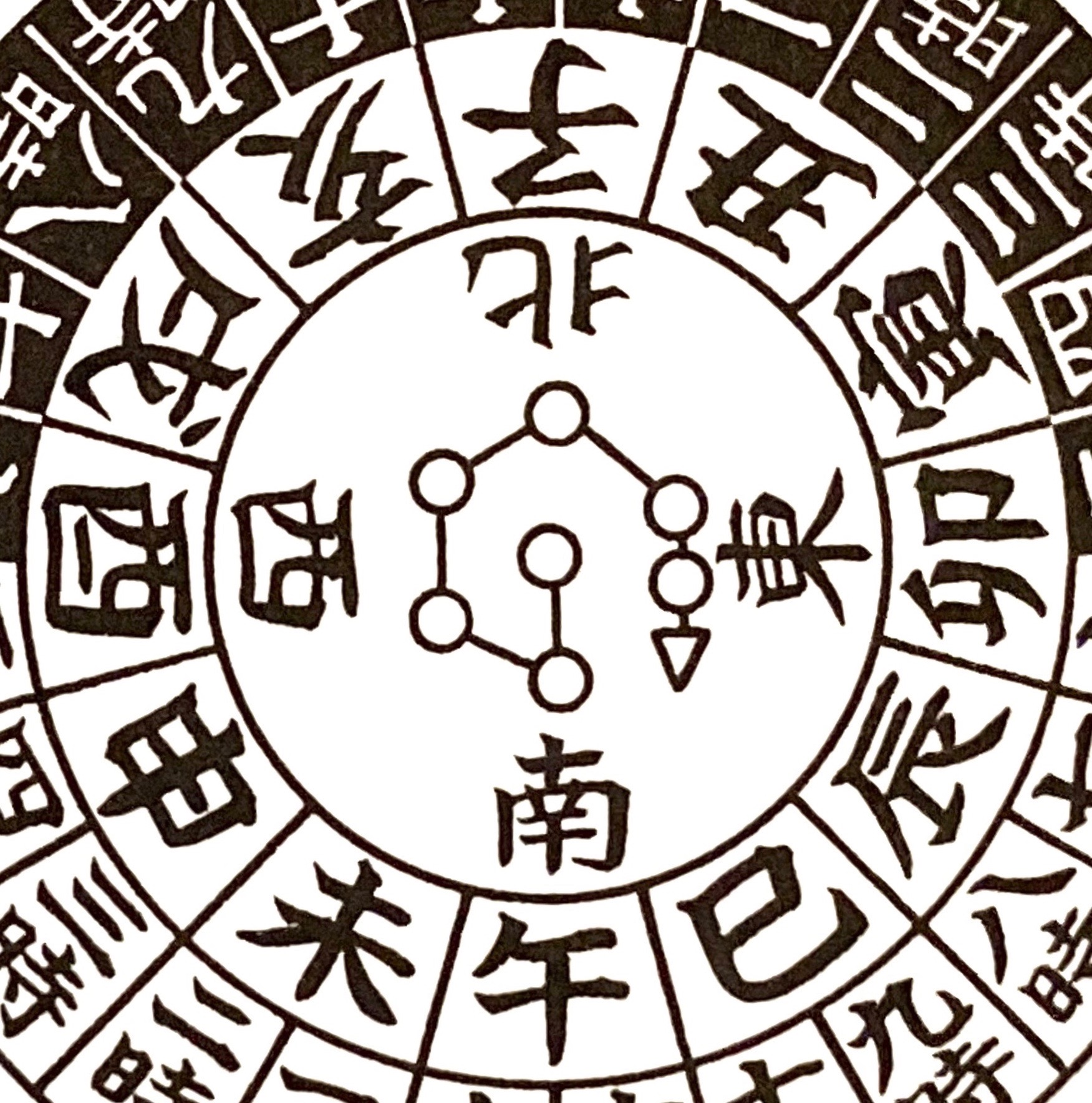
When the host examines the whisk in the water in the chawan, the chasen is lifted with the right hand to examine the tines. The chasen is rotated with the top of the whisk moving toward the host, which is counter-clockwise. This procedure is done three times. The chasen is whisked in the water, and at the conclusion, the chasen is used to draw the hiragana character no, の. This character resembles the central element in the diagram of the Kozu, which is identified as the stars of the Big Dipper: Hoku-to shichi-sei, 北斗七星, north-measure seven-stars. The dipper design format has north, 北, at the bottom. To approximate the relationship between the chawan and the teishu, the diagram is turned 180 degrees so that south is at the bottom. The dipper is oriented to follow the line of the の character from the center to the outer circle.
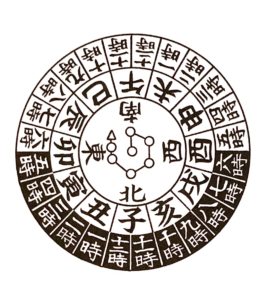
The standard design of the Kozu is composed of three rings: the inner circle of cardinal directions – north south east west; the middle ring the Jū-ni-shi, 十二支, Ten-two-branches (twelve zodiac signs); the outer ring the twelve hours of day, white, and the twelve hours of night, black. The direction of movement is clockwise. Perhaps the movement and lifting and turning of the chasen three times is to emulate the three rings of the Kozu. This would unite the aspects of Time and Space.
The Big Dipper is a grouping of stars within the constellation Ursa Major, Bear Great. The stars of the sky appear from the northern hemisphere to turn counter-clock around Polaris, the pole star, which is relatively unmoving. The stars appear to move clockwise from the southern hemisphere. It is the earth that turns toward the east, ‘counter-clockwise’ .
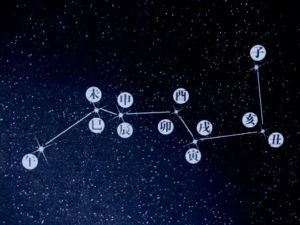
In some interpretations of the stars of the Big Dipper, the seven stars are identified with the twelve animals of the Asian zodiac, Jū-ni-shi, 十二支, Ten-two-branches. It is a curious system because five of the animal signs are ascribed two animal signs each. In the diagram, Ne, 子, Rat, is located in the upper right corner. The next star is Ushi, 牛, Ox, on the bottom of the dipper. The star to the left and on the outside is Tora, 寅, Tiger. The stars continue U, 卯, Hare, Tatsu, 辰, Dragon, Mi, 巳, Snake, to the end of the handle, Uma, 午年, Horse, the star farthest from the Rat star, and return, on the inside, to the Rat star.
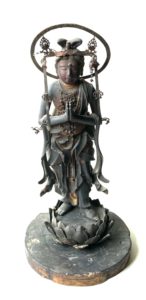
The significance of the sign of Uma/Horse at the handle end, is that the sign of the Uma/Horse is protected by Sei-shi Bo-satsu, 勢至菩薩, Strength-attain Grass-buddha. When the teishu is preparing Tea, and handling the chasen, and other utensils, he or she is metaphorically located in the place of Seishi Bosatsu. Seishi, together with Kannon Bosatsu, who protects the animal sign of the Ne/Rat, accompany A-mi-da, 阿弥陀, Praise-increase-steep, the Buddha of Compassion.
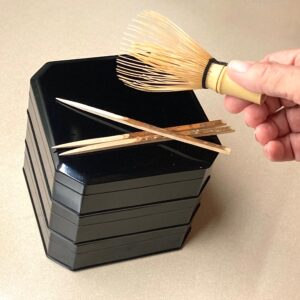
Fuchi-daka, 縁高, edge-high, stack of three black plastic octagonal boxes with a single lid and kuro-mo-ji, 黒文字, black-character-letter, brushwood picks for eating sweets. The cha-sen, 茶筅, tea-whisk is used to sprinkle water, tsuyu-uchi, 露打ち, dew-strike, on the lid to give a fresh and cool impression. ‘Dew’ is also sprinkled on lacquered food bowls. The Kanji for tsuyu, 露, in Buddhism, means satori, 悟り, ‘enlightenment’, which is clearly manifest in the name of the ro-ji, 露地, dew-ground, garden of a Tea hut.
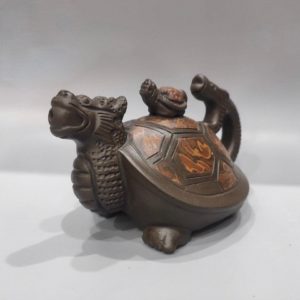
Chinese ceramic teapot in the form of a dragon/snake turtle identified as Gen-bu, 玄武, Black-warrior. Genbu is the emblem of one of the four celestial creates, that rules over the north quadrant of the sky. There is a curious coincidence with the combined dragon / snake turtle, and the two zodiac animals in the southeast direction, Tatsu-Mi, 辰巳, or 巽, Dragon-snake. In ancient China, divination was sought in the cracks in a turtle shell placed over a fire. The turtle / tortoise, Genbu, is believed to live for ten thousand years. In early Chinese prognostication, the long-lived turtle through interpretation of the cracks in specific areas of the hexagons were thought to have symbolic significance. This was accomplished by wisemen, much beyond the capabilities of mere mortals. Eventually, the Kozu, the shell-map, was created to approximate the sections of the turtle shell in symbolic terms, but consolidated the directions and the animal zodiac and time, night and day. Interpretation still required and requires masters of divination. This all filtered into Chanoyu and aspects of the Kozu are manifest in the Ha-kke bon, 八卦盆, Eight-sign tray.
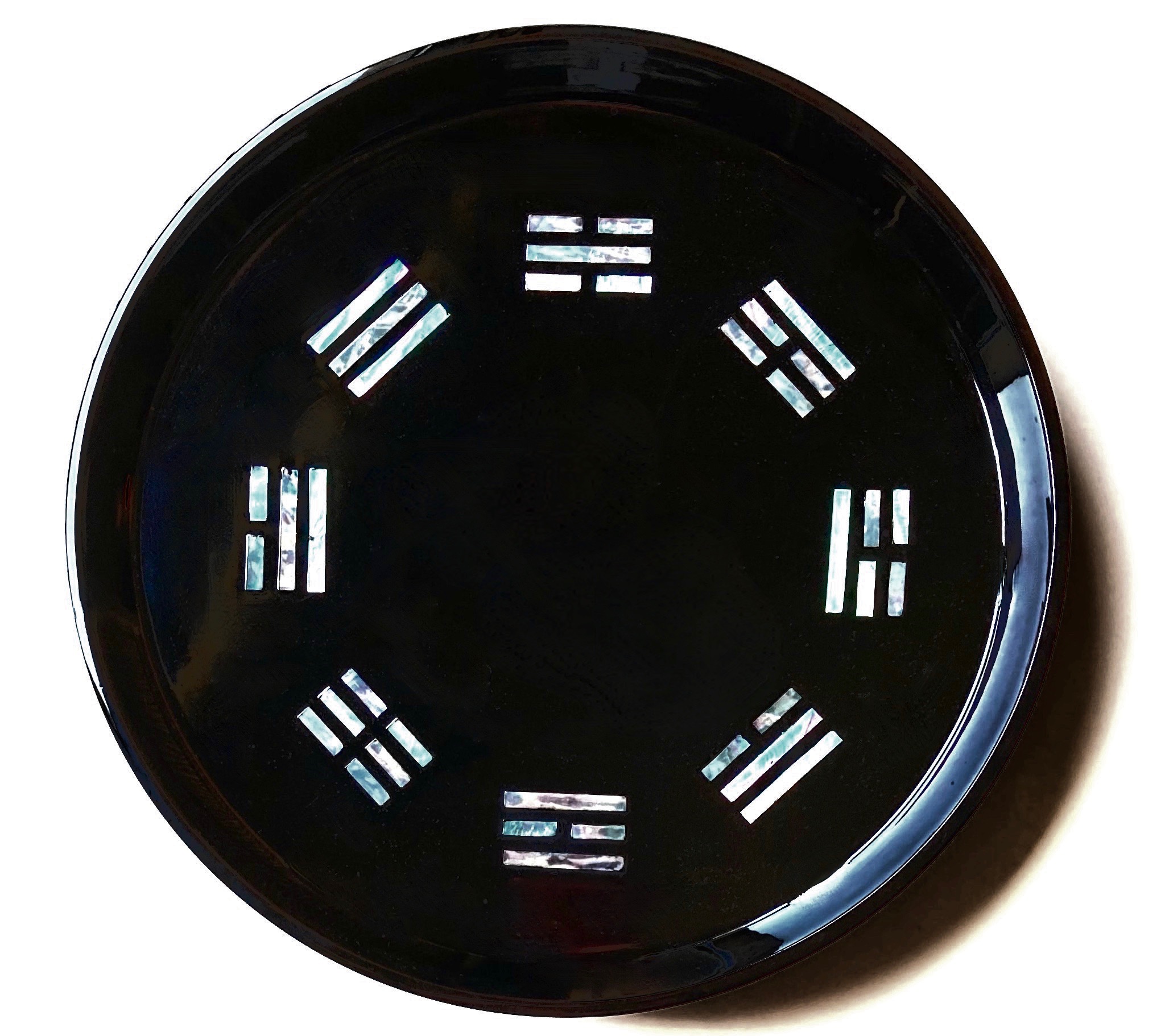
For further study, see also: Chasen, Chasen and the Gorintō, Chasen and Sensu, Chasen Suehiro, Chasen Whisk and Thread, Natsume Chasen Chashaku

